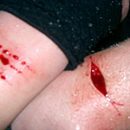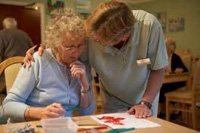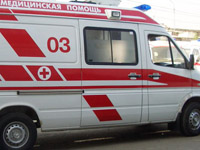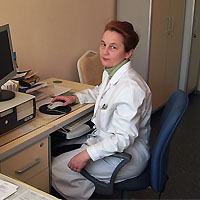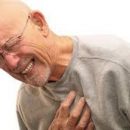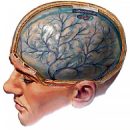Who is subject to reactive psychosis to a greater extent? Did the disease reversible? What are his symptoms? Answers to these and other questions about jet psychosis can be found in this article.
Content
Types and manifestations of jet psychosis
States arising from the impact of factors that are of particular importance for the patient or threatening his life and well-being. One of the main signs of reactive psychosis is their temporary and reversible character. Winds in response to a psychotracting situation, they stop after its permission and disappearance. In the clinical picture, as a rule, is reflected, or «Sounds», Mental injury content.
In contrast to neuroses, also arising from the impact of a psychogenic factor, the reactive psychosis is characterized by a state of state, a large depth of disorders, loss of critical assessment of their condition and occurring around events. The emergence of reactive psychosis, its nature and features of symptoms depend on the strength and significance of mental injury for the individual, as well as on its constitutional features. Reactive psychosis is easier to occur in psychopathic personalities, for example, hysterical, emotionally unstable, paralyonal.
The predisposing factors may be severe somatic diseases transferred in the past crankshaft injuries, long-term alcoholization, forced insomnia, overwork and T.D. The most vulnerable in terms of the occurrence of pathological mental reactions are adolescent and menopacterity periods.
Depending on clinical manifestations, acute reaction states (affective shock reactions) and protracted psychoses are distinguished.
Affective-shock reactions are caused by a sudden strong impact that usually represents a threat to life (fire, earthquake, flooding and T.D.). Manifest in the form of excitation and inhibition. Reactions with excitation are expressed by meaningless chaotic motionable concerns against the background of a narrowed consciousness. The patient is torn, shouts, asks for help, trying to escape, often towards a thirstful danger. After leaving the psychosis, patients badly remember the transferred state. Reactions with inhibition are accompanied by partial or complete immobility (stupor).
Despite the threatening danger, a person is frozen, chainets, can not make moves, say words. The reactive stupor lasts from a few minutes to several hours. Mimica reflects either fright, horror, despair, confusion, or absolute indifference to what is happening. In cases where the inhibition does not reach the degree of stupor, patients are accessible to contact, but they are slowed down, one-way, movements are apparent, in the legs. Consciousness may be narrowed with subsequent falling out of the memory of individual events.
The hysterical psychotic states, arising usually arising in the conditions of judicial situations in the threat of criminal liability can be attributed to acute reactive psychosis. Several options for similar disorders that can be combined or replaced by one other.
-
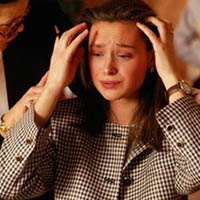 The hysterical twilight permanent of consciousness (Hanzer syndrome) is manifested in «Mimage», T.E. When the patient is clearly understandable to them the question is wrong. The behavior of it is demonstratively, accompanied by either loud laugh, foolishness, or cry, sobbing. Orientation in place, time and surrounding persons violated.
The hysterical twilight permanent of consciousness (Hanzer syndrome) is manifested in «Mimage», T.E. When the patient is clearly understandable to them the question is wrong. The behavior of it is demonstratively, accompanied by either loud laugh, foolishness, or cry, sobbing. Orientation in place, time and surrounding persons violated.
-
Pseudo-degeneration (false dementia) - a condition in which gross, deliberate disorder of orientation in place, time surrounding and self-personality. For the easiest questions, patients give ridiculous answers, and the correct answer may suddenly give. So, the question of how many fingers in their hands, the patient can answer - 7, 15; It can also say that he has 3 eyes, 4 legs. Black calls white, winter - in summer, instead of hand tested. Shoes puts on hands, in the sleeve coat exhibits legs. Eats eggs along with shell. The patient is confused, shouting eyes. On the face there may be a meaningless smile or, on the contrary, sorrow and fear. Pseudo-degeneration lasts from 1-2 weeks to 2 months, usually before the permission of the forensic psychiatric situation. Memories - fragmentary «Everything was like in a dream».
-
Puerylism is a psychotic state with child behavior, usually complements pseudodementation. Patients behave like small children. Childish are building phrases, surviving, whispered, surrounding calling aunts and uncles. Play children's games, capricious. Can not perform elementary tasks or allow rough errors. At the same time, certain skills and stereotypes of adult behavior are preserved, for example, the manner of smoking, use cosmetics.
-
Hysterical stupor - a state of pronounced inhibition with a refusal of eating, hard silence and a narrowed consciousness. In contrast to the usual reactive stupor, when patients are in a state of cutting fading, slowness, stupid, with a hysterical stupor, there is a strong tension of the muscles of the body and the resistance of the patient to any attempt to change its posture. Mimica reflects despair, malice, sorrow. Any reminder of the psychotrauming situation causes vegetative reactions in the form of redness of the skin of the face, the increase in the pulse, breathing. The exit from the sturder state may occur immediately after a favorable resolution of the situation or gradually occurs with the advent of other hysterical symptoms (paralysis, trembling in the body, breach of the gait).
Tightening reactive psychozam include reactive depression and jet paranoid (delusional psychosis). Reactive depression usually arises as a response to death (especially sudden) loved ones, heavy life failures and is accompanied by an depressed mood, weakness, lack of appetite, increasingly. Patients walk bumping, sit with her head lowered on her chest, lie under the foot. All thoughts are connected with the psychotramming situation, its analysis, the desire to discuss these events with the surrounding.
Initially, for example, immediately after notifying the death, there may be a short-term state of stupor, without tears, and only on the outlet of the stupor appear tears with the addition of guilt or repentance. The feeling of own guilt is connected directly with a psychogenic situation: patients blame themselves in the fact that not everyone did to prevent death or alleviate suffering to the close person that they were not attentive to him attentive and fair. However, the thoughts of the patients were directed not in the past, as with a cyclotimic depression, but are associated with the present and future, therefore, the thoughts about the gloomy perspective of loneliness, suffering, material disadvantage with the need of empathy and complicity are always affiliated with the feeling of loss and grief. Suicide thoughts appear only with the complete absence of consistent perspective.
The reactive depression depends on both the nature of the mental injury and the patient's identity features. However, time heals everything, t.E. The forecast is most often favorable. Protective reactive depressions are usually observed in unresolved psychogenic situations. For example, a close man disappeared, and it cannot find it alive, nor dead.
Jet delusional psychosis (paranoid) - false judgments and conclusions arising from patients due to a certain psychotrauming situation. The ideas first can be ultra-supersonal, psychologically understandable, emerging on the real soil and at the first pores of certain correction, but then they go into delusional, with incorrect behavior and lack of criticism in the patient.
Such delusional psychosis may occur in insulation conditions, including language. The emergence of psychosis contributes to the stress of the environment (military conditions), lack of understanding of someone else's speech, customs, as well as their own state, weakened by insomnia, overwork, alcoholization, malnutrition. Fear appears, suspicion, and then thoughts about persecution, possible murder. At the same time, deceptions of perception may arise (more often there are in the trend sitting in single cameras) - patients hear the voices of relatives, acquaintances, crying children. Nonsense relationships and persecution can occur in the taguhuhi due to the difficult perception of speech and improper interpretation of the behavior of others. Recognition of jet paranoids usually does not cause difficulties.
Situational deferredness of psychosis, the immediate connection of its content with a psychotracting situation and reversibility of the state when changing the external situation - the main diagnostic criteria. Reactive paranoids include induced nonsense, resulting from the emotional and psychological influence of a person suffering from crazy psychosis. The latter as if imposes its delusional ideas to another, who is in emotionally close contact (for example, a mentally sick mother - daughter).
To occur such a state, certain conditions are necessary. First, the presence of close communication or joint residence of two people with relative isolation from others (sometimes they are isolated themselves without communicating with other people).
Secondly, induced delusional ideas usually appear on a certain soil, t.E. Personality with psychopathic features (increased sustainability, jam, rigidity, anxiety, tendency to ultra-supersonal formations), mental underdevelopment, low cultural level. The subject of induced delusional ideas is associated with everyday events and is expressed in the ideas of persecution, poisoning, jealousy, and crap. Induced patient, as well as inductor, can be excited and perform socially dangerous actions. Induced psychosis usually passes with a change in the situation and insulation of the patient from the inductor.
How to treat reactive psychosis
For all reactive psychosis, it is necessary, first of all, (where possible) eliminate the cause of the disease - a psychogenic situation. Affective shock reactions if you do not go to another state, usually do not require a doctor help. With other psychosis require hospitalization. Therapeutic tactics are determined by the urgency of the state, the nature of the psychotrauming situation, its intended outcome, as well as the peculiarities of psychopathological symptoms.
In any case, a favorable resolution of a psychogenic situation, for example, the removal of the accusation, evacuation from the disaster area, returning to their homeland from the conditions of language isolation, contributes to rapid recovery. And vice versa, hopeless situation creates conditions for a protracted population of psychosis. Under the states of excitation, neuroleptics and tranquilizers in injections are used. Crazy ideas will be stopped as neuroleptics. With reactive depression apply antidepressants.
The most important element of treatment is psychotherapy, the task of which is the elimination of excessive fixation on the psychotrauming situation and the development of protective psychological mechanisms during the adaptation period to its consequences. Psychotherapeutic work with patients spend only when it leaves from acute psychosis, when he can already adequately perceive the surrounding, including the arguments of the doctor, and critically evaluate the situation and its condition. In most cases, the prognosis is favorable, patients return to work. The forecast is less favorable in the conditions of insoluble or protracted psychotrauming situations, however, there is a transformation of a state and relative adaptation to new conditions.
 The hysterical twilight permanent of consciousness (Hanzer syndrome) is manifested in «Mimage», T.E. When the patient is clearly understandable to them the question is wrong. The behavior of it is demonstratively, accompanied by either loud laugh, foolishness, or cry, sobbing. Orientation in place, time and surrounding persons violated.
The hysterical twilight permanent of consciousness (Hanzer syndrome) is manifested in «Mimage», T.E. When the patient is clearly understandable to them the question is wrong. The behavior of it is demonstratively, accompanied by either loud laugh, foolishness, or cry, sobbing. Orientation in place, time and surrounding persons violated.

